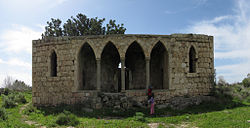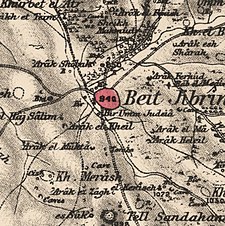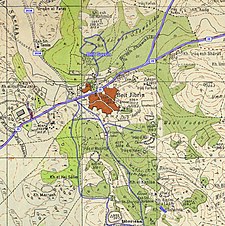
Back بيت جبرين Arabic بيت جبرين ARZ Bayt Jibrin Catalan بیت جبرین Persian Bayt Jibrin Finnish Bayt Jibrin French בית ג'יברין HE Bet-Guvrin Croatian Bayt Jibrin ID Bajt Dżibrin Polish
Bayt Jibrin
بيت جبرين | |
|---|---|
 Historic Bayt Jibrin mansion | |
A series of historical maps of the area around Bayt Jibrin (click the buttons) | |
Location within Mandatory Palestine | |
| Coordinates: 31°36′19″N 34°53′54″E / 31.60528°N 34.89833°E | |
| Palestine grid | 140/112 |
| Geopolitical entity | Mandatory Palestine |
| Subdistrict | Hebron |
| Date of depopulation | 29 October 1948[3] |
| Area | |
| • Total | 56,185 dunams (56.2 km2 or 21.7 sq mi) |
| Population (1945) | |
| • Total | 2,430[1][2] |
| Cause(s) of depopulation | Military assault by Yishuv forces |
| Current Localities | Beit Guvrin (kibbutz)[4] |
Bayt Jibrin or Beit Jibrin (Arabic: بيت جبرين) was an Arab village in the Hebron District of Mandate Palestine, in what is today central Israel, which was depopulated during the 1948 Arab–Israeli War. It was preceded by the Iron Age Judahite city of Maresha, the later Hellenistic Marissa, located slightly south of Beit Jibrin's built-up area; and the Roman and Byzantine city of Beth Gabra, known from the Talmud as Beit Guvrin (also Gubrin or Govrin, Hebrew: בית גוברין, romanized: Beit Gubrin), renamed Eleutheropolis (Greek, Ἐλευθερόπολις, "Free City") after 200 CE. After the 7th-century Arab conquest of the Levant, the Arabic name of Beit Jibrin was used for the first time, followed by the Crusaders' Bethgibelin, given to a Frankish colony established around a Hospitaller castle. After the Muslim reconquest the Arab village of Beit Jibrin was reestablished.
During the days of Herod the Great, Bet Gabra was the administrative center for the district of Idumea.[5][clarification needed] In 200 CE, after the turmoil of the First Jewish–Roman War (64-70) and the Bar Kokhba revolt (132-135), the town became a thriving Roman colony, a major administrative centre and one of the most important cities in the Roman province of Syria Palaestina under the name of Eleutheropolis. The city was then inhabited by Jews, Christians and pagans.[6] Under the British Mandate of Palestine, Bayt Jibrin again served as a district centre for surrounding villages. It was captured by Jewish forces during the 1948 war, causing its Arab inhabitants to flee eastward. Today, many of the Palestinian refugees of Bayt Jibrin and their descendants live in the camps of Bayt Jibrin (ʽAzza) and Fawwar in the southern West Bank.
The kibbutz of Beit Guvrin was established to the north of Bayt Jibrin, on the villages' lands, in 1949. The archaeological sites of Maresha and Beit Guvrin are today an Israeli national park known as Beit Guvrin-Maresha National Park, including their burial caves and underground dwellings, workshops and quarries, which are listed as a UNESCO World Heritage Site.[7] Eleutheropolis remains a titular see in the Roman Catholic Church.[8]
- ^ Department of Statistics, 1945, p. 23 Archived 2015-12-22 at the Wayback Machine
- ^ Village Statistics, Government of Palestine. 1945. Quoted in Hadawi (1970), p. 50 Archived 2011-06-04 at the Wayback Machine
- ^ Morris, 2004, p. xix, village #322. Also gives the cause of depopulation
- ^ Morris, 2004, p. xxii, settlement #166
- ^ Meron Benvenisti et al. (n.d.), p. 255.
- ^ Zissu, B., Ecker, A., and Klein, E, 2017, "Archaeological Explorations North of Bet Guvrin (Eleutheropolis)", in: Speleology and Spelestology, Proceedings of the VIII International Scientific Conference. Naberezhnye Chelny, pp. 183-203.
- ^ Region of the Caves & Hiding: Bet Guvrin-Maresha Archived 2017-10-27 at the Wayback Machine. UNESCO World Heritage Centre.
- ^ Eleutheropolis in Palaestina (Titular See)
© MMXXIII Rich X Search. We shall prevail. All rights reserved. Rich X Search




